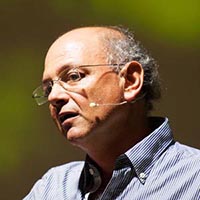By Roberto Natalini
Roberto Natalini interviews Sara Zahedi who is an assistant professor in numerical analysis at the Royal Institute of Technology (KTH) in Sweden. Sara Zahedi is one of ten winners and the only female winner of the European Mathematical Society Prize for 2016.
Sara Zahedi, the only female winner of the European Mathematical Society Prize for 2016.
Q: How did you decide to become a mathematician?
A: My interest and my teacher’s encouragement made me choose this path.
Q: You were born in Teheran, but from the mathematical point of view you grew up in Sweden. How have these two countries influenced your education? Are you still in contact with your country of birth?
A: I came to Sweden when I was 10 years old and have since then studied in Sweden. We had to flee from Iran because people were killed, executed only because they had other political opinions than the regime. Unfortunately, not much has changed so I have never been back.
Q: Could you mention some people who have been important for your mathematical education?
A: First of all, my high school teacher in math and physics, Maj Bodin. She really inspired me. She always said I would either work as a mathematician or physicist. When I started at the University several of my teachers encouraged me, in particular Professor Boris Shapiro. My Ph.D. advisor Professor Gunilla Kreiss introduced me to the world of computational methods for multiphase flow problems. Later I met Professor Mats Larson from whom I have learned very much and he has been able to push me to achieve a lot. Last but not least I have been inspired, and have learned and enjoyed a lot from discussing math with my husband.
Q: What is your main focus in mathematics, the main direction in your research?
A: Development, analysis, and implementation of numerical methods for partial differential equations (PDEs). In particular, finite element methods for PDEs in complex and moving domains.
Q: Is there one scientific result of yours, which is really important to you?
A: The space-time Cut Finite Element Method (CutFEM) we have developed for PDEs in complex and evolving geometries. With the space-time CutFEM we propose solving PDEs in complex and evolving geometries has become much easier. I believe these methods will be cornerstones in future FEM software.
Q: You have a strong focus on applications. Was this your principal interest in research, or you did you find it along the way?
A: I found it along the way. My Ph.D. advisor Professor Gunilla Kreiss introduced me to the world of multiphase flow problems and the challenges there motivated me a lot. ICIAM Newsletter
Q: This summer, during the European Congress of Mathematics, you received one of the ten European Mathematical Society prizes. The citation reads: “For her outstanding research regarding the development and analysis of numerical algorithms for partial differential equations with a focus on applications to problems with dynamically changing geometry.” These prizes are very prestigious. Could you explain better the contributions you have made to deserve the prize? What, in your opinion, are the original ideas that most impressed the prize committee?
A: You have to ask the committee about this! I am proud that I have been able to develop computational methods that efficiently address the challenges computer simulations of phenomena with dynamically changing geometries pose. These methods are simple to implement and of great importance in applications where PDEs need to be solved in complex and evolving geometries where the remeshing process, which standard finite element methods require, is both complicated and expensive.
Q: Is it difficult to balance working life with your family life?
A: Yes. I have two young kids, one and three years old, so right now it is really difficult. But I get enormous help and support from both my husband and mother.
Q: How do you spend your time when you are not working?
A: I spend my time with my family.
Q: What is your favorite non-mathematical activity?
A: Me and my husband used to play a lot of board games. Nowadays there is not much time left to do that but I like to swim and I have a lot of fun when we dance and sing with the kids.
Q: Finally, a last general question of interest to our community: what do you imagine for Applied Mathematics in 2017?
A: I hope in 2017 we can reach out more to young people and our society can attract many more students, especially female students.
This post is being republished from the July issue of Dianoia, the ICIAM newsletter.
 |
Roberto Natalini has been director of the Istituto per le Applicazioni del Calcolo “Mauro Picone” of the National Research Council of Italy since 2014. His research interests include fluid dynamics, road traffic, semiconductors, chemical damage of monuments, and biomathematics. He is on the board of the Italian Society of Industrial and Applied Mathematics and is chair of the Raising Awareness Committee of the European Mathematical Society. |